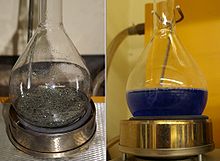Slurry analysis
Slurry analysis is an analysis to determine the nutrient content of the manure .
Liquid manure contains the plant nutrients nitrogen , phosphate , potassium , magnesium , calcium and sulfur . The content of the ingredients can fluctuate considerably due to the different composition of the feed. A slurry analysis makes it possible to determine the contents of the ingredients. With their knowledge, manure fertilization can be optimized in order to supply the soil, surface water and groundwater with the best possible amount of nutrients and not overload them with excessive nutrient intake. Spreading liquid manure close to the ground (e.g. with the drag hose method ) is an environmentally relevant measure that some federal states are funding.

execution
The nutrient content depends on the dry matter of the manure, the type of animal and the feeding. The Association of German Agricultural Testing and Research Institutes (VDLUFA) has laid down the measurement regulations for the slurry analysis .
Analysis regulations for the slurry analysis are (according to the VDLUFA method book, Volume II.1) for example:
- Method 3.2.2 .: Determination of ammonium nitrogen - distillation with magnesium oxide,
- Method 3.5.2.6 .: Determination of total nitrogen - Kjeldahl digestion, Förster method ,
- Method 4.1.1.3 .: Determination of phosphate soluble in mineral acids,
- Method 5.1.3 .: Determination of total potassium as well
- Method 6.1.2 .: Determination of total calcium in fertilizers with organic components.
The results of the manure analysis can be used not only for professional fertilization planning, but also for the nutrient comparison required by the fertilizer ordinance. From farm manure of animal origin, an average of the agriculturally used areas of a farm may not be applied more than 170 kilograms of total nitrogen per hectare per year. Under certain conditions, 230 kilograms of total nitrogen per hectare and year are possible on grassland when a special permit is granted (§ 4 Fertilizer Ordinance ).
Web links
- The study of fertilizers . Volume II. 1. VDLUFA-Verlag, Darmstadt 1995.
- Ordinance on the use of fertilizers, soil additives, growing media and plant additives according to the principles of good professional practice (Fertilizer Ordinance - DüV) (HTML version) of the BMELV
- Agri-environmental program of the state of Baden-Württemberg (PDF file, 473 kB) of the MLR

